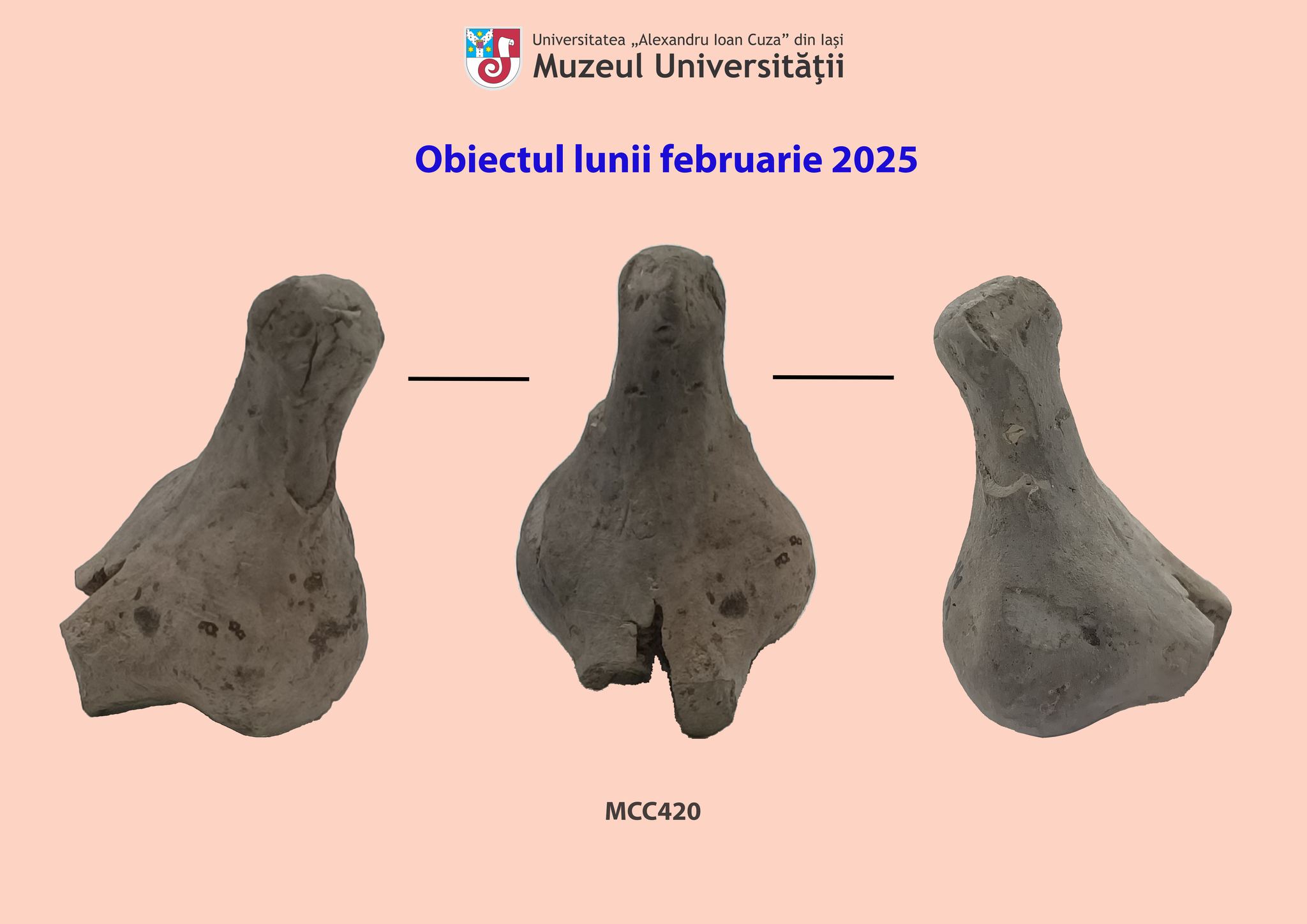
Iași: Exponatul lunii februarie 2025 la Muzeul Universității “Alexandru Ioan Cuza”: Poduri – Rusăiești, 2004. Caseta A, □E14, adâncime -4,03 m. Cultura Cucuteni, Faza A1, cca. 4600-4440 a.Chr.
3 februarie - 28 februarie

Poduri – Rusăiești, 2004. Caseta A, □E14, adâncime -4,03 m.
Cultura Cucuteni, Faza A1, cca. 4600-4440 a.Chr.
Statuetă antropomorfă feminină, deteriorată din vechime. Modelată manual dintr-o pastă semi-fină, aceasta are o culoare gri-cenușie. Capul statuetei are un aspect mai curând animalier, iar brațele sau alte proeminențe pe trunchi, sunt absente. Ochii sunt marcați asimetric, iar gura (și sânii?) sunt abia schițate, realizate, cel mai probabil, prin mici ciupituri cu unghia. Bazinul și zona fesieră puternic evidențiate sunt modelate astfel încât să transmită ideea de fertilitate și abundență și să-i confere stabilitate piesei în poziție așezată. Picioarele sunt separate printr-o incizie adâncă, ce le desparte complet, un mod de redare mai rar întâlnit pentru statuetele feminine.
Observația atentă scoate în evidență și alte trăsături distinctive ale acestei piese fragmentare. Pe suprafață sunt vizibile crăpături, nu din cauza deteriorării, ci dintre cele ce apar în mod caracteristic în momentul în care pasta de modelat prezintă umiditate scăzută și o crustă uscată. Pentru a acoperi acest neajuns, pe alocuri, făuritorul statuetei a utilizat tușe de pastă umedă acoperind suprafața cu un strat subțire, moale.
Această neglijență este însoțită de altele: cel puțin trei urme de amprente sunt vizibile pe suprafața statuetei, iar pe lângă acestea, cel puțin șapte urme de unghii sunt observabile, altele decât marcajele anatomice. Obiectul poate constitui un bun obiect de studiu pentru varietatea de detalii neobișnuite.
înălțime: 42 mm
greutate: 16 grame
Nr. inventar: MCC420 (1820).
Poduri – Rusăiești, 2004
Excavation unit A, grid square E14, depth -4,03 m.
A female anthropomorphic statuette, damaged in ancient times. It is manually modelled from a semi-fine paste and has a greyish colour. The head of the statuette has a rather animalistic appearance, and the arms or other protrusions on the upper body are absent. The eyes are asymmetrically marked, and the mouth and possibly the breasts (?) are barely outlined, most likely created with small pinches from a fingernail. The pelvis and strongly emphasised buttocks are shaped in such a way as to convey the idea of fertility and abundance, and to provide the idol with stability in a seated position. The legs are separated by a deep incision, completely dividing them, a less common method of representation for female statuettes.
A careful observation reveals other distinctive features of this fragmentary piece. Cracks are visible on the surface, not due to damage, but of the type that typically appear when the modelling paste has low moisture and a dry crust. To cover this shortcoming, the creator of the statuette used strokes of wet paste, covering the surface with a thin, soft layer.
This carelessness is accompanied by others: at least three fingerprints are visible on the surface of the statuette, and in addition, at least seven other nail marks, distinct from the anatomical markings, can be observed. The object could serve as an excellent study piece due to its variety of unusual details.
height: 42 mm
weight: 16 grams
Inventory number: MCC420 (1820)